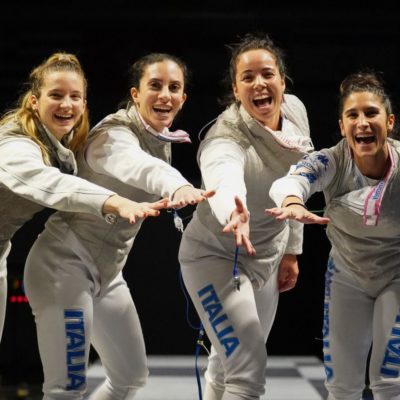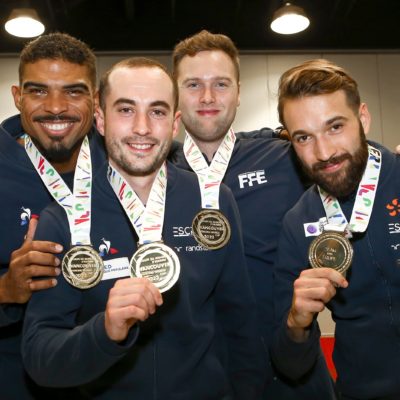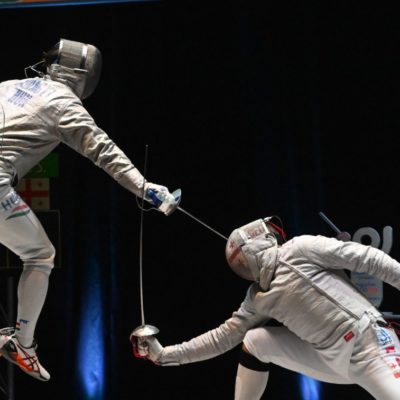Olympic fencing has come and gone. Four years is the perfect amount of time between Olympic Games. Any more frequent, and they wouldn’t carry the same gravitas and significance. Any less frequent, and the media hype would be unbearable. Here is the Fencing.Net breakdown of the 28th Olympiad, our review of the action and our guesses for future trends in fencing.
|
| Mariel Zagunis ascends to fencing heaven, finally free of earthly concerns. Photo courtesy Serge Timacheff/FencingPhotos.com |
Our coverage of the NBC coverage
|
Most fencers were overjoyed to learn that NBC would televise the sport. The recognition is nice, of course, but there was more to it. Some fencers were curious about what Olympic-caliber fencing actually looked like. It’s an odd state of affairs when afficionados of a sport aren’t used to seeing it played at its highest levels. Can Olympic-level fencing be seriously developed in America, if there isn’t a common vision of the far goal?
So it didn’t take long for the issues to pop up: Fencers scream when they hit? Fencers look askance at directors after questionable calls? Fencers express!? The questions prompt (sometimes uncomfortable) answers, and then there is long debate. It’s all good. In the end, 30 seconds of Sada Jacobson on Bravo has probably ended dozens of small-salle arguments, clarified the meaning of footwork for hundreds of up-and-coming fencers, and spared our coaches a collective thousand man-hours of explanations.
The coverage also left US fencing with a new level of public mindshare and a wealth of enduring images: Zagunis flying through the air, wrapped in a flag. Ivan Lee channelling the some very high blood pressure into his Podzniakov bout. The US Men’s Sabre Team, one call away from a medal, twice. Erin Smart, dejected, covered from the omnipresent cameras by an American-flag waving friend. The picture of Tiompkin hanging in the air over his opponent (you can almost hear him telling the team: “Guys, watch this. I’m getting on the front page!”).
|
The general viewing audience may think fencing is a small sport, but fencing has never thought this. Athletes who will never be millionaires strut like prima-donnas, and do flips when they win the Gold. Teams trash-talk, like on city handball courts. They form conga lines, unlike on city handball courts. Contests are personal, and real, and globe-spanning. The national coverage of fencing has blown this wide open — and if “perception is reality,” then the reality of fencing has undergone a shift.
Next: The USA’s future in fencing
{mospagebreak}USA: Strong future in fencing
The USA has had its strongest combined showing at the Olympics since the middle ages, 1956. The Men’s Sabre Team and the Men’s Foil Team placed fourth. These are great placements, usually reserved for the traditional fencing superpowers. There is very little room at the top, and every high result must displace a long-time occupant. This year, the USA tied Germany for medals, and also knocked them out of Men’s Foil Team.
And the personal results are even more encouraging. Gold for Mariel Zagunis in Women’s Individual Sabre. Bronze for Sada Jacobson (Jacobson will always be the USA’s first woman medalist). And the non-medal results speak volumes. Dan Kellner (MF) upset Cedric Gohy of Belgium. Keeth Smart beat Gael Touya FRA, while Ivan Lee eliminated Gianpiero Pastore ITA. Soren Thompson upset the number one seed, Alfredo Rota ITA, and made the highest Men’s Epee result in four decades — and the highest men’s individual fencing result in 2004. When US fencers are eliminated, they now take several fencers down with them.
|
The most striking change in American fencing is the talent pool, which has widened and deepened since the 1980’s. These fencers began with strong coaching, in their teens or earlier. Dan Kellner started with Simon Gershon before Simon could speak English. We are only now seeing the first fruits from an orchard 20 years in the making, and the orchard will be productive for decades to come.
US fencing’s upward climb won’t end after this Olympics. Even given the fierce post-Olympic turnover rate, as fencers drop out to find jobs or continue school, many fencers will return to competition, or at least gut-check the next generation (Ann Marsh likes to do this). Most of our fencers are easily young enough to attend another Olympics, even two or three, but it’s up to them to hold down a job and fight off young up-and-comers if they want to do it.
Thanks, USFA!
In the end analysis, the US has apparently found a formula that works. It’s not only excellent athleticism, dedication and training on the part of the fencers… the USFA has fashioned an apparatus that can build amateur competitors of the highest caliber. The emphasis on elite athletes is paying off with excitement and elevated public interest. The number of fencing web-hits and “how do I fence?” emails is through the roof. Our team for the 2016 Olympics is right now asking its mother to find a fencing salle on the intarweb.
As Jed Dupree (men’s foil) said, “The future belongs to us.”
Next: Shifts in world fencing
{mospagebreak}World fencing — the march of time
Having a vested interest in Team USA made this Olympic Games very engrossing, but that’s only part of it. The foreign competitors were also very well known and recognizable — we care about them, we know their history. We feel Gruchala’s pain, when she’s on strip against Vezzali. Vezzali, Trillini, Pozdniakov, Kolobkov, Bissdorf — if you follow international fencing, these fencers are as familiar as old shoes. Old being the operative word. Many of recognized super-stars will be retiring out of the sport before the next Olympics, and there will be particular problems replacing them. When superstars have dominated their national rankings for too long, gathering all the sunlight, there is a chance the lesser fencers have grown anemic in the shade.
|
When Sanzo injures himself conclusively using his on-strip yoga, where is the 4th-string Italian who has been placing at all the world cups? Vezzali and Trillini are nearing retirement age — is there is another stern Italian foil dominatrix waiting in the wings? The problem is simple: What’s better than dominating international fencing, year after year? Doing it with different fencers.
The USA already has that level of churn, not having institutionalized fencing or possessing quasi-professional fencers. If Erin Smart hadn’t made it to the Olympics, one of the Zimmermans or Emily Cross would have. When does an Italian give up his “fence all day” job as a policeman, so the next generation can step up? Tomorrow, or sometime after that.
We are looking at significant shifts in the next few years. Many of the heavies at this Olympics won’t be around for the next. They certainly earned their berth to these Games, but new fencers are already squishing through the fingers of their indomnitable grip, causing many interesting upsets: Montano vs Nemcsik for gold in Men’s Sabre; Hee Kyunk Park KOR knocking out Andre Wessels GER in Men’s Foil; 19-year-old Renal Ganeev RUS beating Ralf Bissdorf GER (33 years old, 2002 World Champion). The recognizable, familiar names are ending their runs. New fencers will appear in their place.
Next: Which new fencers will appear?
{mospagebreak}National prospects
|
Italy is on top this year, with medals in most categories. Italian fencing is brilliant, but brittle — it places a premium on fast improvisation, thin shavings of tempo, and great flexibility — it is fencing which requires attitude to work. Some of their strongest fencers are aging out of competition. Luigi Tarantino (31), Giovanna Trillini (34) and Valentina Vezzali (30) are of retireable age. The two top women dominate their weapon, so this would be a blow to the Italian program. It will be interesting to view the replacements — will they fence cheerfully, like most Italians, or will the fencing be darker, like the top women? Italy’s male foilists are mostly still young (the eldest is Sanzo, 29), but they play a very pitch-perfect, acrobatic game which doesn’t age well. Look for new faces in the coming years, either by turnover or injury.
Germany
Germany is in dire straits. Foil’s Joppich and Wessels are young but not placing, Bissdorf is grown up and not placing. Germany needs to improve its stars, grow new ones, or change the direction of its coaching. Where it once ruled the world, women’s foil is now empty, Simone Bauer (31 years) being Germany’s sole competitor. Meanwhile, Germany has no sabre, and a toe-hold in team epee. Germany was almost eclipsed by the USA in fencing medals, tying the score on the last day with a Bronze in Men’s Team Epee. If Germany is cultivating its next generation of fencers, it may be several years before they’re seasoned and ready to go.
|
France
France has several stars, they work well in teams, and have some depth. Brice Guyart (Gold Medal Winner) is only 23, and this is his second Olympics; he may have two more. France is only getting better in epee, with Fabrice and Jerome Jeannet, Eric Boisse and Hughes Obry, consistently showing at the highest levels and yet still traveling towards their peak. And it takes a strong sabre culture to top Italy and Russia, as France did in Men’s Team Sabre. Though they never slacked off, the French are often eclipsed by flashier fencers from other countries. Their results always seem to feel lucky, rather than inevitable or hard-won. Nonetheless, based on these games, France is in the early stages of a growth spurt, adding strength on strength. Also, watch for the Frech tip-technique to blossom with the box-timing changes coming for foil.
Russia
Russia has also become interesting again. They may not have many super-stars, but the team performances were strong, and this also is an indicator of depth. Team results — 1st place Women’s Epee, 3rd place Men’s Sabre, 3rd place Men’s Foil, and 4th place Men’s Epee — Russia got its medals by burning steady rather than bright, and most of the fencers are in their early 20’s. Pavel Kolobkov (35 years old), Stanislav Pozdniakov (31) and Renal Ganeev (19!) are particular standouts, but Ganeev is the one with a long road ahead of him. As the older fencers begin retiring throughout the world in the next few years, this new Russian crop will fill the gaps.
China
China is the largest of the nations that “get” fencing, and yet they have an odd international un-presence. It’s a safe guess that there is little fencing for pleasure in rural China. If China is like most other Stalinist autocracies, then Chinese fencers are machined in the metropolii, within a very centralized and structured framework. This makes for unbelievably strong fencers, all sharing the same blind spots — like when Italy marching-attacked them to death in the 2003 Men’s Foil Team World Championships. Like any shallow gene pool, when China ventures out of the pacific rim world cups, they either dominate or get wiped out by a sneeze.
China’s star women’s sabrist, Tan Xue, has now been fencing for 5 years, and has an exciting future ahead of her. China also silvered in Men’s Team Foil (or won, depending on the director), and next year will make an even stronger challenge to the Italians. Lei Wang silvered in Men’s Individual Epee, beating Kolobkov. Li Zhang lost to eventual Women’s Epee Gold Medalist Timea Nagy HUN in the round of eight, but only barely, 9-8. China, already a powerhouse, will keep growing, especially now that they have another Olympic’s worth of data to study back at home base. Tan might have been speaking mechanically for all of China in 2002, when she told a state newspaper, “I am still young and I will be training harder for further improvement.”












